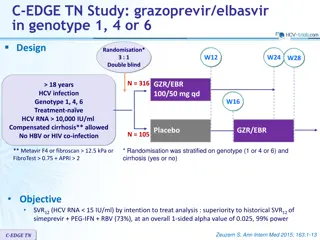
Hadoop Foundation for Analytics & Key Advantages
Explore the history, needs, features, and key advantages of Hadoop, an open-source project by Apache foundation, used for big data analytics. Learn about its scalability, data protection, and computing infrastructure. Discover why companies like Facebook and Yahoo rely on Hadoop for storing and processing massive data sets efficiently.
Download Presentation

Please find below an Image/Link to download the presentation.
The content on the website is provided AS IS for your information and personal use only. It may not be sold, licensed, or shared on other websites without obtaining consent from the author. If you encounter any issues during the download, it is possible that the publisher has removed the file from their server.
You are allowed to download the files provided on this website for personal or commercial use, subject to the condition that they are used lawfully. All files are the property of their respective owners.
The content on the website is provided AS IS for your information and personal use only. It may not be sold, licensed, or shared on other websites without obtaining consent from the author.
E N D
Presentation Transcript
Big Data Analytics Unit IV : Hadoop Foundation For Analytics Dr.S.Chitra, Assistant Professor, Department of Computer Science, Annai Vailankanni Arts and Science College, Thanjavur
Hadoop Hadoop is An Open source project of the Apache foundation Framework written in java Uses Googles MapReduce and Google File System technologies as its foundation Core part of the computing infrastructure for companies : yahoo,flipkart
History of Hadoop Developed : Doug Cutting, 2005,Creator of Apache Lucene ( text search Library) created to support distribution Nutch , text search engine Doug added DFS and MapReduce to Nutch Doug Cutting and Mike Cafarella Cloudera founded Started working on Nutch 2002 2003 2004 2005 2006 2007 2008 2009 Google published GFS and MapReduce Doug Cutting joined Cloudera Yahoo hired Doug Hadoop spins out Nutch
Needs of Hadoop Inherent data protection Storage Flexibility Low cost Needs of Hadoop Computing power Scalability
Features of Hadoop Handle massive quantities of structures, Semi Structured and unstructured data Shared nothing architecture Replicates its data across multiple computers High throughput rather than low latency Complement of OLAP and OLTP Not a replacement for RDBMS Not good for dependencies within the data Not good for processing small files Best for huge data files and data sets
Key Advantages of Hadoop Stores data in its native format No loss of information as there is no translation / transformation to any specific schema Scalability proven to scale by companies like facebook & yahoo Delivers new insights Higher Availability Fault tolerance through replication of data / fail over across computer nodes Reduced cost lower cost / terabyte of storage and processing H/W can be added or swapped in or out of a cluster
Versions of Hadoop Limitations of Hadoop1.0 Advantages of Hadoop 2.0 Hadoop 1.0 : Hadoop 2.0: YARN [ Yet Another Resource Negotiator] Requirement of MapReduce Programming expertise along with java. Data Storage Framework: MapReduce programming expertise no required HDFS[Hadoop Distributed File System] Schema less Stores data files in any format Supports only batch processing. It supports both batch processing and real time processing Parallel Tasks, flexibility, Scalability and efficiency Tightly coupled with MapReduce. Data Processing Framework: Map Reduce Mappers: key-value pairs and generate intermediate data Reducers: produce the output data
RDBMS vs Hadoop Parameters RDBMS Hadoop System Relational Database Systems Structured Data OLTP Data needs consistent relationship Needs expensive hardware or high end processor to store huge amount of data Node based flat structure Structured and Unstructured Analytical and big data processing Big data processing does not require consistent relationship Requires only a processor, network card and few hard drives 4,000 per terabytes of storage Data processing Choice processor Cost 10,000 to 14,000 per terabytes of storage
Hadoop Overview Open Source Software framework, distributed fashion on large clusters of hardware Accomplishes two tasks 1. Massive Data Storage 2. Faster Data Processing
Ke y Aspects of Hadoop Open Source Software: free to download,use and contribute to Framework : to develop and execute applicatio Distribued : parallel across multiple conneced nodes Massive Storage Faster Processig : Parallel,quick response
Hadoop Components Hadoop Ecosystem FLUME MAHOUT ---- OOZIE HIVE SQOOP HBASE PIG Core Components: MapReduce Programming Hadoop Distributed File System (HDFS)
Hadoop Core Components 1. HDFS: 2. Map Reduce: Computational framework Splits a task across multiple nodes Processes data in parallel Storage Component Distributes data across several nodes Natively redundant
Hadoop Ecosystem 1. HDFS : stores data files to original format 2. Hbase : Hadoop s database, supports structured data storage for large files 3. Hive : analysis of large data set using language ANSI SQL 4. Pig : data flow language, data converted into Map Reduce jobs automatically 5. ZooKeeper: coordination service for distributed applications 6. Oozie: workflow scheduler system to manage jobs 7. Mahout: scalable machine learning and data mining library 8. Chukwa : data collection system for managing large distributed system 9. Sqoop : transfer bulk data between Hadoop and structured data stores 10. Ambari: web-based tool for provisioning, managing and monitoring Apache
Hadoop Conceptual layer Conceptually divided into two layers 1. Data Storage Layer : stores huge volume of data 2. Data processing layer : process data in parallel to extract meaningful insights from data.
Hadoop Architecture Hadoop has a master-slave topology. One master node and multiple slave nodes. Master node : assign a task to various slave nodes manage resources and metadata. Slave nodes : actual computing and store the real data. Hadoop Architecture comprises three major layers. 1. HDFS (Hadoop Distributed File System) 2. Yarn 3. MapReduce (Contd..)
1. HDFS (Hadoop Distributed File System) HDFS has a Master-slave architecture. It provides for data storage of Hadoop. HDFS splits the data unit into smaller units called blocks It has got two daemons , master node NameNode and slave nodes DataNode. a. NameNode and DataNode : NameNode : runs on the master server. Responsible : Namespace management and regulates file access by the client. DataNode : runs on slave nodes. Responsible : storing actual business data. NameNode also keeps track of mapping of blocks to DataNodes. DataNodes serves read/write request from the file system s client. DataNode also creates, deletes and replicates blocks on demand from NameNode.
Secondary NameNode: There is a third daemon or a process called Secondary NameNode. The Secondary NameNode works concurrently with the primary NameNode as a helper daemon. Functions of Secondary NameNode: constantly reads all the file systems & writes it into the hard disk or the file system. It is responsible for combining the EditLogs with FsImage from the NameNode. It downloads the EditLogs from the NameNode at regular intervals and applies to FsImage. The new FsImage is copied back to the NameNode.
b. Block in HDFS : Block : smallest unit of storage on a computer system. It is the smallest contiguous storage allocated to a file. In Hadoop, we have a default block size of 128MB or 256 MB.
c. Replication Management To provide fault tolerance, HDFS uses a replication technique. It makes copies of the blocks and stores in on different DataNodes. Replication factor decides how many copies of the blocks get stored. It is 3 by default but we can configure to any value.
d. Rack Awareness : A rack contains many DataNode and there are several such racks in the production. HDFS follows a rack awareness algorithm : to place the replicas of the blocks in a distributed fashion. It provides for low latency and fault tolerance. Advantages of Rack Awareness: To improve the network performance To prevent loss of data:
HDFS Read/ Write Architecture: HDFS follows Write Once Read Many Philosophy. can t edit files already stored in HDFS. But, append new data by re- opening the file. HDFS Write Architecture: HDFS client write a file named example.txt of size 248 MB. The client will be dividing the file example.txt into 2 blocks one of 128 MB (Block A) and the other of 120 MB (block B).
The steps to write data into HDFS: HDFS client Write Request against the two blocks, say, Block A & B. NameNode grant permission for client and provide IP addresses of the DataNodes . The selection of IP addresses of DataNodes is purely randomized based on availability, replication factor and rack awareness. The NameNode provided following lists of IP addresses to the client: For Block A, list A = {IP of DataNode 1, IP of DataNode 4, IP of DataNode 6} For Block B, set B = {IP of DataNode 3, IP of DataNode 7, IP of DataNode 9} Each block be copied in three different DataNodes to maintain the replication factor consistent throughout the cluster.
The whole data copy process will happen in three stages: 1. Set up of Pipeline 2. Data streaming and replication 3. Shutdown of Pipeline (Acknowledgement stage) 1. Set up of Pipeline: Before writing , the client confirms whether the DataNodes, present in IP List, are ready to receive the data or not. the client creates a pipeline for each of the blocks by connecting the individual DataNodes in the respective list for that block. Let us consider Block A. The list of DataNodes provided by the NameNode is:
For Block A, list A = {IP of DataNode 1, IP of DataNode 4, IP of DataNode 6}.
For block A, the client will be performing the following steps to create a pipeline: 1. The client choose the first DataNode in the list, DataNode 1 and establish a TCP/IP connection. 2. The client inform DataNode 1 to be ready to receive the block. 3. It also provide the IPs of next two DataNodes (4 and 6) to the DataNode 1 where the block is supposed to be replicated. 4. The DataNode 1 connect to DataNode 4. The DataNode 1 inform DataNode 4 to be ready to receive the block and give IP of DataNode 6. 5. DataNode 4 tell DataNode 6 to be ready for receiving the data. 6. Next, the acknowledgement of readiness follow the reverse sequence, i.e. From the DataNode 6 to 4 and then to 1. 7. At last DataNode 1 inform the client that all the DataNodes are ready and a pipeline will be formed between the client, DataNode 1, 4 and Now pipeline set up is complete and the client will finally begin the data copy or streaming process.
2. Data Streaming: As the pipeline has been created, the client push the data into the pipeline. Data is replicated based on replication factor. So, here Block A will be stored to three DataNodes as the assumed replication factor is 3. Moving ahead, the client will copy the block (A) to DataNode 1 only. The replication is always done by DataNodes sequentially.
The following steps will take place during replication: Once the block has been written to DataNode 1 by the client, DataNode 1 connect to DataNode 4. Then, DataNode 1 push the block in the pipeline and data will be copied to DataNode 4. Again, DataNode 4 connect to DataNode 6 and will copy the last replica of the block.
3. Shutdown of Pipeline or Acknowledgement stage: Once the block has been copied into all the three DataNodes. A series of acknowledgements will take place to ensure the client and NameNode that the data has been written successfully. Then, the client finally close the pipeline to end the session. In the figure below, the acknowledgement happens in the reverse sequence i.e. from DataNode 6 to 4 and then to 1. Finally, the DataNode 1 push three acknowledgements into the pipeline and send to the client. The client inform NameNode that data has been written successfully. The NameNode will update its metadata and the client will shut down the pipeline.
Similarly, Block B also copied into the DataNodes in parallel with Block A. So, the following things are to be noticed here: The client will copy Block A and Block B to the first DataNode simultaneously. Two pipelines be formed for each of the block and all the process discussed above happen in parallel in these two pipelines. The client writes the block into the first DataNode and then the DataNodes will be replicating the block sequentially.
As you can see in the above image, there are two pipelines formed for each block (A and B). Following is the flow of operations that is taking place for each block in their respective pipelines: For Block A: 1A -> 2A -> 3A -> 4A For Block B: 1B -> 2B -> 3B -> 4B -> 5B -> 6B
HDFS Read Architecture: HDFS Read architecture is comparatively easy to understand. Let s take the above example again where the HDFS client wants to read the file example.txt now.
Now, following steps will be taking place while reading the file: The client reach out to NameNode asking for the block metadata for the file example.txt . The NameNode return the list of DataNodes where each block (Block A and B) are stored. After that client connect to the DataNodes where the blocks are stored. The client starts reading data parallel from the DataNodes (Block A from DataNode 1 and Block B from DataNode 3). Once the client gets all the required file blocks, it combine these blocks to form a file. HDFS selects the replica which is closest to the client. This reduces the read latency and the bandwidth consumption.













